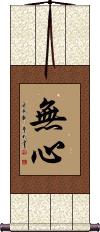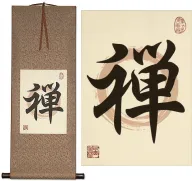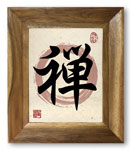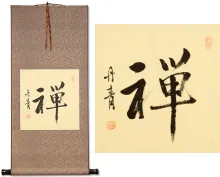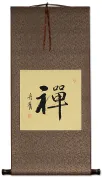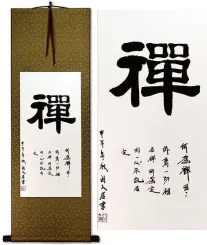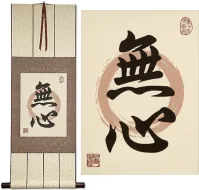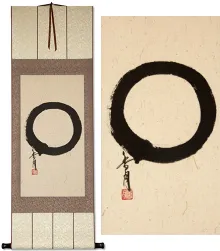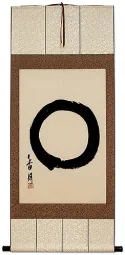Many custom options...
And formats...

Not what you want?
Try other similar-meaning words, fewer words, or just one word.
Feel free to email me with your request. If it's easy, I'll translate it for free and add it to this database of calligraphy for you.
Shin Zen in Chinese / Japanese...
Buy a Shin Zen calligraphy wall scroll here!
Personalize your custom “Shin Zen” project by clicking the button next to your favorite “Shin Zen” title below...
Kemo no Shin
No Mind / Mushin
In Japanese, 無心 means innocent or without knowledge of good and evil. It literally means “without mind.”
無心 is one of the five spirits of the warrior (budo) and is often used as a Japanese martial arts tenet. Under that context, places such as the Budo Dojo define it this way: “No mind, a mind without ego. A mind like a mirror which reflects and dos not judge.” The original term was “mushin no shin,” meaning “mind of no mind.” It is a state of mind without fear, anger, or anxiety. Mushin is often described by the phrase “Mizu no Kokoro,” which means “mind like water.” The phrase is a metaphor describing the pond that clearly reflects its surroundings when calm but whose images are obscured once a pebble is dropped into its waters.
This has a good meaning in conjunction with Chan / Zen Buddhism in Japan. However, out of that context, it means mindlessness or absent-mindedness. To non-Buddhists in China, this is associated with doing something without thinking.
In Korean, this usually means indifference.
Use caution and know your audience before ordering this selection.
More info: Wikipedia: Mushin
This in-stock artwork might be what you are looking for, and ships right away...
Gallery Price: $90.00
Your Price: $49.88
Gallery Price: $106.00
Your Price: $58.88
Gallery Price: $106.00
Your Price: $58.88
Gallery Price: $72.00
Your Price: $39.77
Gallery Price: $108.00
Your Price: $59.88
Gallery Price: $90.00
Your Price: $49.88
Gallery Price: $200.00
Your Price: $98.88
Gallery Price: $150.00
Your Price: $88.88
Not the results for shin zen that you were looking for?
Below are some entries from our dictionary that may match your shin zen search...
| Characters If shown, 2nd row is Simp. Chinese |
Pronunciation Romanization |
Simple Dictionary Definition |
前秦 see styles |
qián qín qian2 qin2 ch`ien ch`in chien chin Zen Shin |
Former Qin of the Sixteen Kingdoms (351-395) the former Qín |
和尚 see styles |
hé shang he2 shang5 ho shang wajou / wajo わじょう |
Buddhist monk (1) (honorific or respectful language) preceptor or high priest (in Shingon, Hosso, Ritsu or Shin Buddhism); (2) second highest priestly rank in Buddhism; (3) master (of one's art, trade, etc.); (1) (honorific or respectful language) preceptor or high priest (in Tendai or Kegon Buddhism); (2) second highest priestly rank in Buddhism; (3) monk (esp. the head monk of a temple); (4) master (of one's art, trade, etc.); (1) (honorific or respectful language) preceptor or high priest (esp. in Zen or Pure Land Buddhism); (2) second highest priestly rank in Buddhism; (3) monk (esp. the head monk of a temple); (4) master (of one's art, trade, etc.); (personal name) Wajō A general term for a monk. It is said to be derived from Khotan in the form of 和闍 or 和社 (or 烏社) which might be a translit. of vandya (Tibetan and Khotani ban-de), 'reverend.' Later it took the form of 和尚 or 和上. The 律宗 use 和上, others generally 和尚. The Sanskrit term used in its interpretation is 鳥波陀耶 upādhyāya, a 'sub-teacher' of the Vedas, inferior to an ācārya; this is intp. as 力生 strong in producing (knowledge), or in begetting strength in his disciples; also by 知有罪知無罪 a discerner of sin from not-sin, or the sinful from the not-sinful. It has been used as a synonym for 法師 a teacher of doctrine, in distinction from 律師 a teacher of the vinaya, also from 禪師 a teacher of the Intuitive school. |
宗派 see styles |
zōng pài zong1 pai4 tsung p`ai tsung pai shuuha / shuha しゅうは |
sect (1) sect; denomination; (2) school (e.g. of poetry) Sects (of Buddhism). In India, according to Chinese accounts, the two schools of Hīnayāna became divided into twentysects. Mahāyāna had two main schools, the Mādhyamika, ascribed to Nāgārjunaand Āryadeva about the second century A. D., and the Yogācārya, ascribed toAsaṅga and Vasubandhu in the fourth century A. D. In China thirteen sectswere founded: (1) 倶舍宗 Abhidharma or Kośa sect, representing Hīnayāna,based upon the Abhidharma-kosa-śāstra or 倶舍論. (2) 成實宗 Satyasiddhi sect, based on the 成實論 Satyasiddhi-śāstra,tr. by Kumārajīva; no sect corresponds to it in India; in China and Japan itbecame incorporated in the 三論宗. (3) 律宗 Vinaya or Discipline sect, basedon 十誦律, 四分律, 僧祗律, etc. (4) 三論宗 The three śāstra sect, based on theMādhyamika-śāstra 中觀論 of Nāgārjuna, theSata-śāstra 百論 of Āryadeva, and theDvādasa-nikāya-śāstra 十二門論 of Nāgārjuna; this schooldates back to the translation of the three śāstras by Kumārajīva in A. D. 409. (5) 涅槃宗 Nirvāṇasect, based upon the Mahāparinirvāṇa-sūtra 涅槃經 tr. byDharmaraksa in 423; later incorporated in Tiantai, with which it had much incommon. (6) 地論宗 Daśabhūmikā sect, based on Vasubandhu's work on the tenstages of the bodhisattva's path to Buddhahood, tr. by Bodhiruci 508,absorbed by the Avataṃsaka school, infra. (7) 淨土宗 Pure-land or Sukhāvatīsect, founded in China by Bodhiruci; its doctrine was salvation throughfaith in Amitābha into the Western Paradise. (8) 禪宗 dhyāna, meditative or intuitional sect, attributed toBodhidharma about A. D. 527, but it existed before he came to China. (9) 攝論宗, based upon the 攝大乘論 Mahāyāna-saṃparigraha-śāstra byAsaṅga, tr. by Paramārtha in 563, subsequently absorbed by the Avataṃsakasect. (10) 天台宗 Tiantai, based on the 法華經 SaddharmapuṇḍarīkaSūtra, or the Lotus of the Good Law; it is aconsummation of the Mādhyamika tradition. (11) 華嚴宗 Avataṃsaka sect, basedon the Buddhāvataṃsaka-sūtra, or Gandha-vyūha 華嚴經 tr. in 418. (12) 法相宗 Dharmalakṣaṇa sect, established after thereturn of Xuanzang from India and his trans. of the important Yogācāryaworks. (13) 眞言宗 Mantra sect, A. D. 716. In Japan twelve sects are named:Sanron, Hossō, Kegon, Kusha, Jōjitsu, Ritsu, Tendai, Shingon; these areknown as the ancient sects, the two last being styled mediaeval; therefollow the Zen and Jōdo; the remaining two are Shin and Nichiren; at presentthere are the Hossō, Kegon, Tendai, Shingon, Zen, Jōdo, Shin, and Nichirensects. |
心宗 see styles |
xīn zōng xin1 zong1 hsin tsung Shin Shū |
The intuitive sect, i. e. the Ch'an (Zen) school; also 佛心宗; 禪宗. |
世間善心 世间善心 see styles |
shì jiān shàn xīn shi4 jian1 shan4 xin1 shih chien shan hsin seken zen shin |
mental state of mundane goodness |
久松真一 see styles |
hisamatsushinichi ひさまつしんいち |
(person) Hisamatsu Shin'ichi (1889-1980) - philosopher, scholar of Zen Buddhism and master of the Japanese tea ceremony |
善決定心 善决定心 see styles |
shàn jué dìng xīn shan4 jue2 ding4 xin1 shan chüeh ting hsin zen ketsujō shin |
attitude of wholesome determination |
Variations: |
oshou(和尚)(p); kashou; wajou / osho(和尚)(p); kasho; wajo おしょう(和尚)(P); かしょう; わじょう |
(1) (honorific or respectful language) {Buddh} (trad. pronounced おしょう in Zen and Pure Land, かしょう in Tendai and Kegon, わじょう in Shingon, Hosso, Ritsu and Shin Buddhism) priestly teacher; preceptor; (2) (おしょう, かしょう only) {Buddh} monk (esp. the head monk of a temple); priest; head priest; (3) {Buddh} (See 法眼・2) second highest priestly rank in Buddhism; (4) master (of one's art, trade, etc.) |
The following table may be helpful for those studying Chinese or Japanese...
| Title | Characters | Romaji (Romanized Japanese) | Various forms of Romanized Chinese | |
| Kemo no Shin | 悕望の心 | kemou no shin kemounoshin kemo no shin | ||
| No Mind Mushin | 無心 无心 | mu shin / mushin | wú xīn / wu2 xin1 / wu xin / wuxin | wu hsin / wuhsin |
| In some entries above you will see that characters have different versions above and below a line. In these cases, the characters above the line are Traditional Chinese, while the ones below are Simplified Chinese. | ||||
Successful Chinese Character and Japanese Kanji calligraphy searches within the last few hours...

